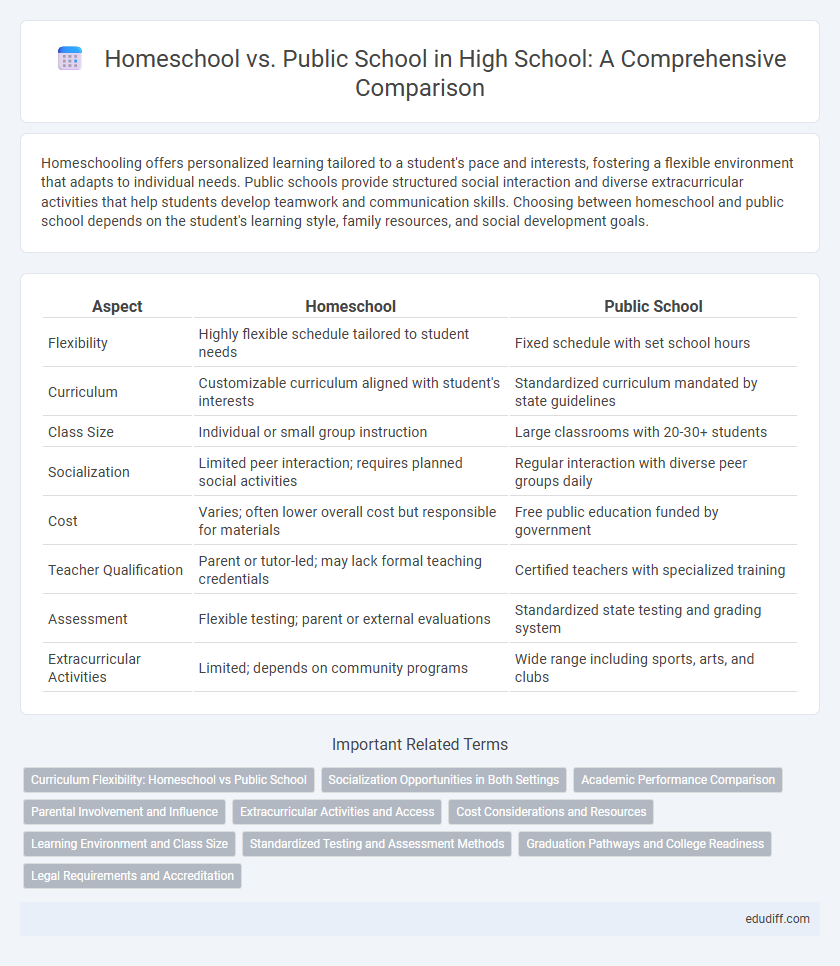Homeschooling offers personalized learning tailored to a student's pace and interests, fostering a flexible environment that adapts to individual needs. Public schools provide structured social interaction and diverse extracurricular activities that help students develop teamwork and communication skills. Choosing between homeschool and public school depends on the student's learning style, family resources, and social development goals.
Table of Comparison
| Aspect | Homeschool | Public School |
|---|---|---|
| Flexibility | Highly flexible schedule tailored to student needs | Fixed schedule with set school hours |
| Curriculum | Customizable curriculum aligned with student's interests | Standardized curriculum mandated by state guidelines |
| Class Size | Individual or small group instruction | Large classrooms with 20-30+ students |
| Socialization | Limited peer interaction; requires planned social activities | Regular interaction with diverse peer groups daily |
| Cost | Varies; often lower overall cost but responsible for materials | Free public education funded by government |
| Teacher Qualification | Parent or tutor-led; may lack formal teaching credentials | Certified teachers with specialized training |
| Assessment | Flexible testing; parent or external evaluations | Standardized state testing and grading system |
| Extracurricular Activities | Limited; depends on community programs | Wide range including sports, arts, and clubs |
Curriculum Flexibility: Homeschool vs Public School
Homeschooling offers unparalleled curriculum flexibility, allowing personalized learning pace, tailored subjects, and integration of experiential activities aligned with the student's interests and goals. Public school curricula follow standardized state guidelines, ensuring uniformity but limiting adaptability to individual student needs or learning styles. This structured approach in public schools facilitates access to certified teachers and resources while homeschooling demands proactive parental involvement to design and implement effective educational plans.
Socialization Opportunities in Both Settings
Homeschooling offers personalized socialization through diverse activities such as community groups, sports teams, and co-op classes, fostering close-knit peer interactions and tailored social experiences. Public schools provide consistent, daily social engagement with a large, diverse student population, enabling students to develop communication skills, teamwork, and broader social networks. Both settings support social development, but public schools typically offer more structured opportunities for spontaneous social interaction and inclusion in extracurricular activities.
Academic Performance Comparison
Homeschool students often demonstrate higher standardized test scores and more personalized learning outcomes compared to public school peers. Research indicates that individualized instruction in homeschooling can lead to better mastery of academic concepts and flexible pacing tailored to each student's needs. However, public schools offer structured curricula validated by education authorities, providing a broad range of resources and social learning environments that also contribute significantly to academic achievement.
Parental Involvement and Influence
Parental involvement in homeschooling typically leads to tailored educational experiences that closely align with family values and learning styles, fostering deeper academic engagement. In public schools, parental influence is often limited to extracurricular activities and communication with teachers, restricting direct control over curriculum content and daily instruction. Studies indicate that higher parental participation in education correlates with improved student performance, highlighting the significant impact of active parental roles in homeschooling environments.
Extracurricular Activities and Access
Public schools generally offer a broader range of extracurricular activities, including sports teams, music programs, and clubs, providing students with diverse opportunities for social engagement and skill development. Homeschool students often face limited access to organized group activities but can participate in community-based programs, co-ops, and specialized interest groups tailored to their needs. Access to facilities and structured events is typically more extensive in public schools, contributing to varied experiences beyond academic curriculum.
Cost Considerations and Resources
Homeschooling can significantly reduce costs related to transportation, school supplies, and extracurricular fees, though parents often invest in curriculum materials and technology. Public schools offer access to diverse resources like specialized teachers, extracurricular programs, and state-funded facilities at minimal or no direct cost to families. Families must weigh the upfront expenses of homeschooling against the broader resource availability and potential hidden costs of public education.
Learning Environment and Class Size
Homeschooling offers a highly personalized learning environment with flexible schedules and one-on-one instruction, fostering individualized attention tailored to each student's pace and interests. Public schools provide diverse social interactions and structured curriculums within classrooms typically ranging from 20 to 30 students, promoting collaborative learning and exposure to group dynamics. Smaller homeschool settings minimize distractions and allow for in-depth exploration, while public school class sizes encourage peer engagement and standardized assessments.
Standardized Testing and Assessment Methods
Homeschool students often experience personalized assessment methods that emphasize mastery of subjects through tailored testing schedules, contrasting with the rigid standardized testing formats common in public schools. Public schools primarily rely on state-mandated standardized tests like the SAT, ACT, and state assessments to measure student achievement and school performance. This difference impacts academic pacing, with homeschoolers able to progress at individualized speeds, while public school students follow uniform testing benchmarks.
Graduation Pathways and College Readiness
Graduation pathways in homeschool programs often offer personalized curricula tailored to individual learning paces, enhancing mastery of core subjects compared to standardized public school requirements. College readiness for homeschoolers can be strengthened through customized test preparation, specialized coursework, and flexible scheduling, supporting higher standardized test scores and targeted extracurricular achievements. Public schools provide structured guidance and access to Advanced Placement (AP) courses, dual enrollment options, and college counseling services that align with traditional college admission standards.
Legal Requirements and Accreditation
Homeschooling in high school requires parents to adhere to state-specific legal requirements, including curriculum approval, record-keeping, and standardized testing, ensuring compliance with education laws. Public schools must maintain accreditation through state or regional education boards, guaranteeing that they meet established academic standards and curriculum guidelines. Proper accreditation and legal adherence impact college admissions and the acceptability of transcripts for homeschooled and public school students alike.
Homeschool vs Public School Infographic

 edudiff.com
edudiff.com